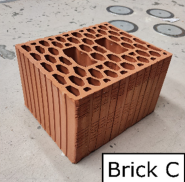Inzunza-Araya Ernesto, Saloustros Savvas, and Beyer Katrin
i Doctoral Assistant, EPFL EESD, Lausanne, Switzerland, ernesto.inzunza@epfl.ch
ii Scientist, EPFL EESD, Lausanne, Switzerland, savvas.saloustros@epfl.ch
iii Associate Professor, Lausanne, Switzerland, katrin.beyer@epfl.ch
ABSTRACT
Masonry walls are critical structural elements in buildings subjected to seismic actions. Their seismic performance is strongly influenced by the mechanical properties of the masonry units, particularly the vertical and horizontal compressive strengths of the bricks. During an earthquake, damage in unreinforced masonry (URM) walls initiates with cracking at the head and bed joints and can propagate through the bricks, affecting the overall drift capacity. Although current design recommendations recognize the possible impact of horizontal compressive strength, its effect on deformation capacity has not been extensively investigated. A previous experimental study explored the seismic response of URM shear walls, primarily analyzing shear strength, ultimate drift, effective stiffness, and failure mechanisms. The work presented here expands on previous research by incorporating additional experimental data and providing a more detailed evaluation of deformation capacity at multiple limit states, from initial cracking to axial load collapse. Six shear-compression tests were conducted on URM walls built with vertically perforated clay bricks and standard cement mortar, using three types of bricks with similar vertical strength but varying compressive strength ratios (0.09, 0.20, and 0.29). The walls (1.5 m long, 2.0 m high, 0.25 m thick) were tested under two levels of compression load with double-bending boundary conditions to promote shear-controlled failure. Beyond the assessment of ultimate drift, this study also examines the maximum crack widths at different limit states and their implications for deformation capacity. The experimental results highlight variations in failure mechanisms and provide new insights into the relationship between the horizontal-to-vertical compressive strength ratio and the seismic performance of masonry walls. These findings contribute to a better understanding of local damage progression and its correlation with global structural behavior, offering valuable data for refining design approaches for modern URM structures.
KEYWORDS: Unreinforced masonry, drift capacity, hollow clay bricks, experimental testing, seismic performance.
081-Inzunza.pdf



